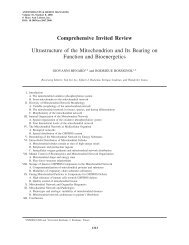MiPsummer Programme pdf - Mitochondrial Physiology Society
MiPsummer Programme pdf - Mitochondrial Physiology Society
MiPsummer Programme pdf - Mitochondrial Physiology Society
Create successful ePaper yourself
Turn your PDF publications into a flip-book with our unique Google optimized e-Paper software.
77<br />
Abstract # 45<br />
Dietary restriction of mice on a high-fat diet induces substrate efficiency and improves<br />
metabolic health.<br />
Loes P M Duivenvoorde, Evert M van Schothorst, Annelies Bunschoten and Jaap Keijer<br />
Human and Animal <strong>Physiology</strong>, Wageningen University, Wageningen, the Netherlands.<br />
Jaap.keijer@wur.nl<br />
Background High energy intake and, specifically, high dietary fat intake challenge the mammalian<br />
metabolism and correlate with many metabolic disorders such as obesity and diabetes. Dietary<br />
restriction (DR) is known to prevent the development of metabolic disorders. The current western<br />
diets are highly enriched in fat, and it is as yet unclear whether DR on a certain high-fat diet elicits<br />
similar beneficial effects on health.<br />
Objective: To assess health beneficial responses of DR of a HFD<br />
Methods: C57BL/6J mice were given either an libitum moderate high fat diet (30 en %; HF) or 30<br />
% restriction of the same diet (HF-DR). Metabolic parameters were analysed and whole genome<br />
microarray analysis of white adipose tissue (WAT) was performed.<br />
Results. Already after five weeks of restriction, the serum levels of cholesterol and leptin were<br />
significantly decreased in HF-DR mice, whereas their glucose sensitivity and serum adiponectin<br />
levels were increased. The body weight and measured serum parameters remained stable in the<br />
following 7 weeks of restriction, implying metabolic adaptation. Gene expression in WAT was<br />
strongly influenced by HF-DR; in total, 8643 genes were differentially expressed between both<br />
groups of mice, with a major role for genes involved in lipid metabolism, mitochondrial functioning<br />
and metabolic flexibility. This was confirmed by quantitative real-time reverse transcription-PCR<br />
and substantiated by increase in mitochondrial density in WAT of HF-DR mice.<br />
Conclusions. DR of HF improves health parameters and gene expression profiles related to<br />
substrate efficiency and metabolic flexibility. This is associated with increased mitochondrial<br />
density, which may be a marker for adipose tissue health.<br />
Journal of Molecular Endocrinology (2011) 47, 81–97



